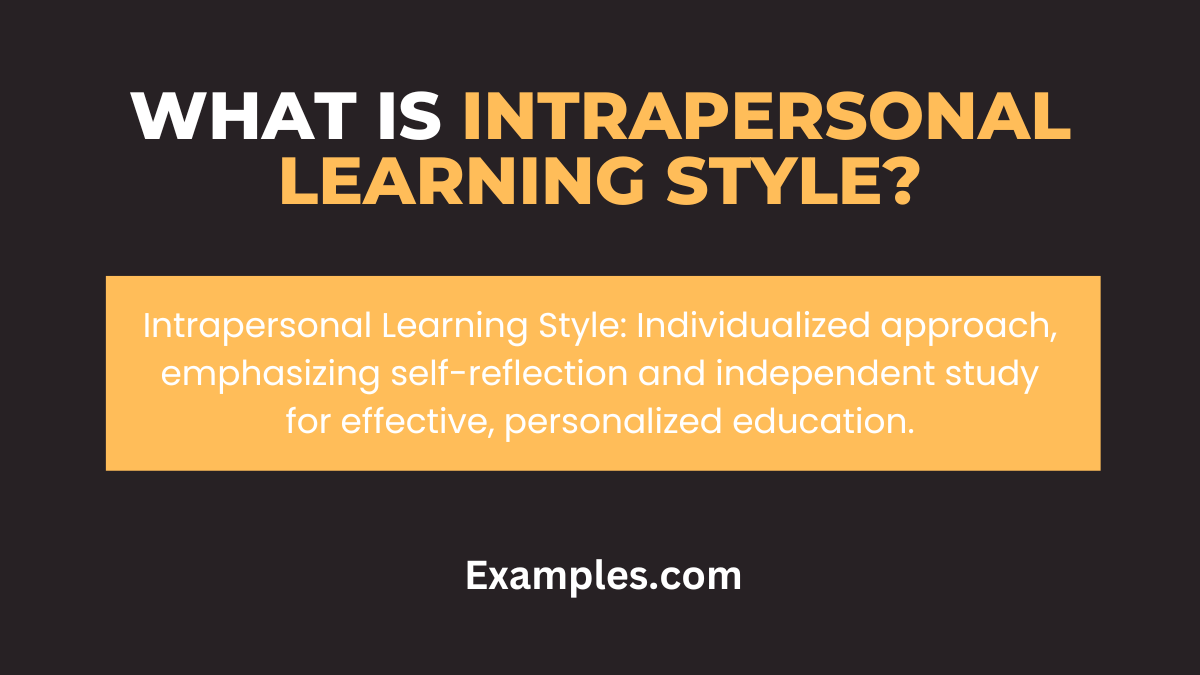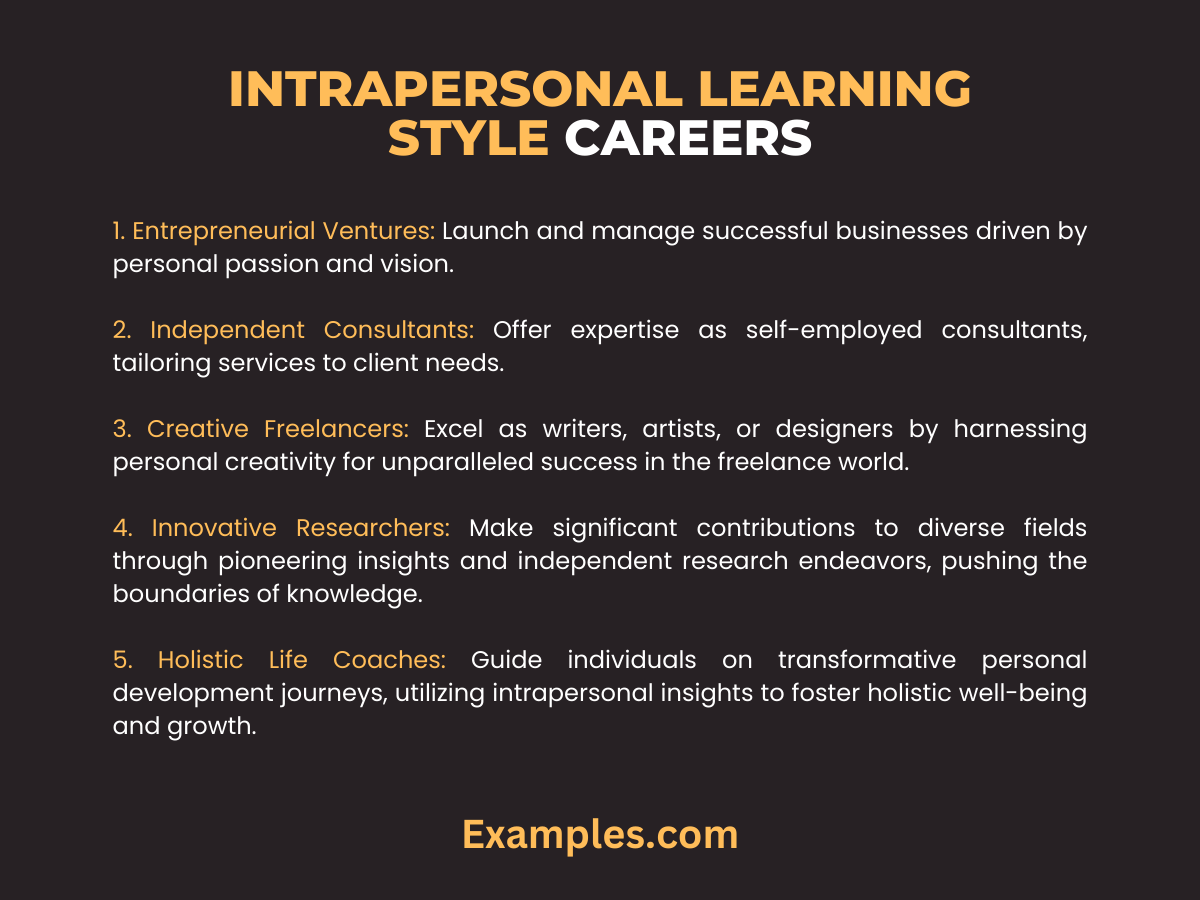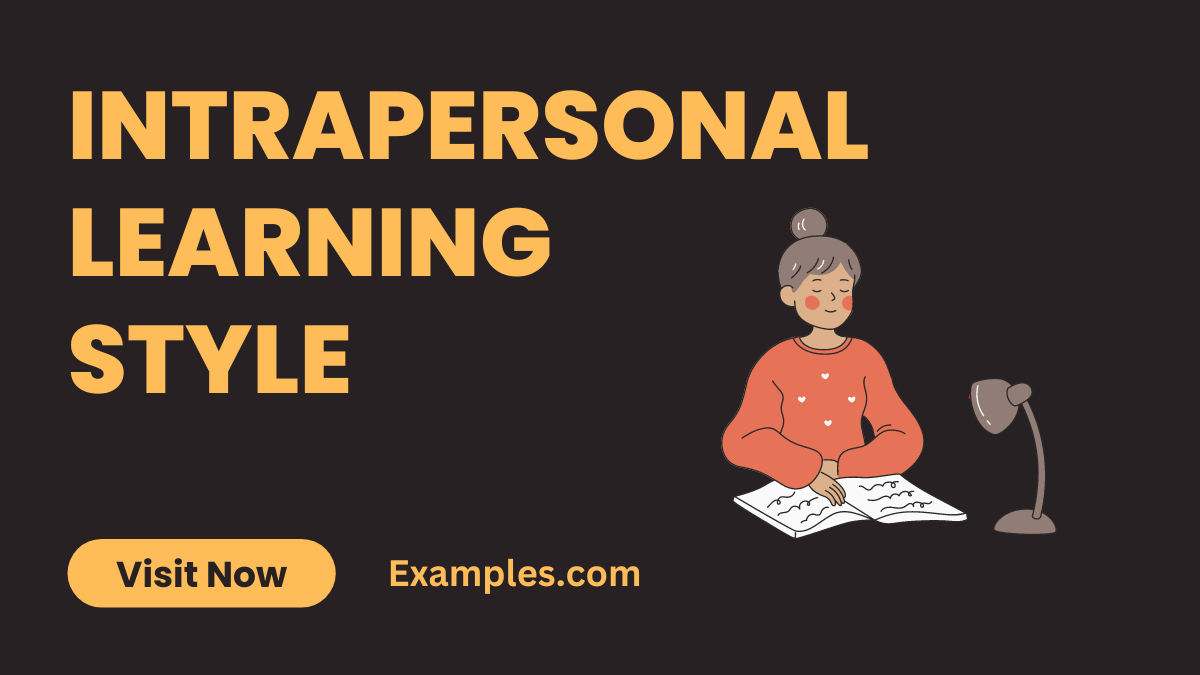19+ Intrapersonal Learning Style Examples
Unlock the secrets of the Intrapersonal Learning Style in this comprehensive guide. Dive deep into understanding your unique way of learning, accompanied by vivid examples that resonate with various Communication Styles. Explore how this learning approach enhances your personal and professional growth. With insights, strategies, and real-life Communication Examples, this guide is your key to harnessing the power of Intrapersonal Learning for effective self-discovery and communication mastery.
What is Intrapersonal Learning Style?

Intrapersonal Learning Style refers to a distinctive way individuals absorb and process information, primarily through introspection and self-reflection. In simple terms, it involves understanding oneself, recognizing personal strengths, and adapting learning strategies accordingly. This learning style emphasizes independent study, solitary exploration, and deep internalization of knowledge. Uncover the essence of Intrapersonal Learning Style as we break down its clear meaning, making it accessible for all learners seeking a personalized and effective approach to education.
What is the best Example of Intrapersonal Learning Style?
Intrapersonal Learning Style shines through in individuals who excel in self-directed education. Consider a scenario where a person prefers solitary study, introspection, and setting personal goals. They thrive when given the autonomy to manage their learning process, reflecting on experiences and internalizing knowledge. This could involve maintaining a personal journal, engaging in deep self-analysis, or utilizing visualization techniques. Uncover the nuances of this exemplary Intrapersonal Learning Style as we delve into a detailed exploration, illustrating its impact on effective and independent learning.
20 Intrapersonal Learning Style Examples

Explore 20 diverse Intrapersonal Learning Style examples, each showcasing the power of personalized learning. From solo research projects to self-paced goal-setting, these examples empower individuals to excel through independent study and internal reflection.
- Research Journaling: Maintain a personal research journal, delving deep into topics of personal interest.
- Goal-Driven Study: Set and achieve self-imposed learning objectives, fostering a sense of accomplishment.
- Visualization Techniques: Utilize visualization for enhanced understanding and retention of information.
- Solo Project Management: Successfully complete projects through independent planning and execution.
- Self-Reflective Essays: Craft essays that delve into personal insights and reflections on acquired knowledge.
- Autonomous Skill Development: Master new skills through self-directed learning and hands-on exploration.
- Personalized Reading Lists: Curate reading lists tailored to individual learning preferences and objectives.
- Mind Mapping for Ideas: Use mind maps to organize thoughts and ideas, fostering creativity.
- Strategic Time Management: Develop a personalized study schedule aligned with peak focus times.
- Meditative Learning: Integrate meditation into the learning process for enhanced concentration and understanding.
- Self-Analysis Exercises: Engage in periodic self-analysis exercises to identify strengths and areas for improvement.
- Personal Project Portfolio: Build a portfolio showcasing personal achievements and acquired skills.
- Independent Research Papers: Explore and document topics of interest through self-initiated research papers.
- Reflective Blogging: Share personal insights and learning experiences through a reflective blog.
- Intuitive Learning Practices: Trust intuition as a guide for understanding complex concepts and ideas.
- Immersive Learning Experiences: Seek out immersive learning opportunities tailored to individual preferences.
- Autobiographical Writing: Develop a personal narrative that intertwines life experiences with acquired knowledge.
- Digital Learning Platforms: Leverage online platforms for personalized, self-guided education.
- Learning Through Art: Use artistic expressions to convey and internalize newfound knowledge.
- Personalized Skill Challenges: Create challenges to continually improve and refine personal skills
Intrapersonal Learning Style Strategies:
Discover effective Intrapersonal Learning Style strategies that tailor education to individual needs. From personalized study routines to reflective practices, these strategies empower learners to navigate their unique learning journey with confidence and efficiency.
- Reflective Goal Setting: Strategically set and achieve personal learning objectives through mindful reflection.
- Adaptive Time Blocking: Organize study sessions based on personal energy levels for optimal concentration.
- Personalized Learning Resources: Curate a diverse set of resources aligning with individual learning preferences.
- Mindful Self-Assessment: Periodically assess learning progress, adapting strategies based on self-reflection.
- Customized Study Environments: Design study spaces that resonate with personal comfort and creativity.
Intrapersonal Learning Style Activities:
Explore engaging Intrapersonal Learning Style activities that transform education into a personalized adventure. From introspective exercises to hands-on projects, these activities foster a love for learning by aligning with individual interests and preferences.
- Personal Development Journaling: Document personal growth and insights through dedicated journaling.
- Independent Research Projects: Embark on self-initiated research endeavors exploring fascinating topics.
- Creative Expression Workshops: Participate in art, writing, or music workshops as a form of self-expression.
- Self-Guided Learning Tours: Design and embark on learning journeys tailored to personal interests.
- Mindful Learning Retreats: Engage in focused, self-directed learning during mindful retreat experiences.
Intrapersonal Learning Style Careers:

Explore how individuals with Intrapersonal Learning Styles excel in various careers, utilizing their unique approach to learning in professional settings. From entrepreneurship to creative fields, these careers highlight the adaptability and innovation of intrapersonal learners.
- Entrepreneurial Ventures: Launch and manage successful businesses driven by personal passion and vision.
- Independent Consultants: Offer expertise as self-employed consultants, tailoring services to client needs.
- Creative Freelancers: Flourish as writers, artists, or designers, leveraging personal creativity for success.
- Innovative Researchers: Contribute groundbreaking insights to fields through independent research endeavors.
- Holistic Life Coaches: Guide individuals on personal development journeys, leveraging intrapersonal insights.
What Are the Intrapersonal Learner’s Characteristics?
Intrapersonal learners exhibit distinctive traits that set them apart in the educational landscape. Understanding these characteristics is essential for tailoring educational approaches. Here’s an in-depth exploration of what defines Intrapersonal Learning Style:
- Self-Reflective Nature: Intrapersonal learners possess a deep inclination towards self-reflection, constantly evaluating their thoughts and actions for personal growth.
- Independent Study Preference: These individuals thrive in self-directed learning environments, where autonomy and independence drive their educational pursuits.
- Goal-Oriented Approach: Intrapersonal learners set and pursue personal goals with determination, channeling their efforts towards self-improvement.
- Introspective Decision-Making: Decision-making involves thorough introspection, as Intrapersonal learners analyze choices based on personal values and insights.
- Emphasis on Personal Interests: Learning is most effective when aligned with personal interests, allowing Intrapersonal learners to stay engaged and motivated.
- Individualized Learning Paths: These learners excel when crafting customized learning paths, tailoring study routines and resources to suit their preferences.
- Effective Time Management: Intrapersonal learners often exhibit strong time management skills, optimizing study sessions to coincide with peak concentration periods.
- Comfort in Solitude: They find solace and focus in solitary environments, preferring to work and learn independently without external distractions.
- Innate Curiosity: A natural curiosity drives intrapersonal learners to explore diverse topics of interest, contributing to a well-rounded knowledge base.
- Continuous Self-Assessment: Regular self-assessment is a key characteristic, as Intrapersonal learners monitor their progress and adjust strategies accordingly.
Study Tips for Intrapersonal Learners
Intrapersonal learners thrive on independent study, introspection, and personalized approaches to education. This comprehensive guide provides tailored study tips to enhance the academic experience for those with an Intrapersonal Learning Style.
- Self-Reflective Planning: Begin by reflecting on personal strengths, weaknesses, and learning preferences. Craft a study plan that aligns with individual goals and preferences.
- Create a Personalized Study Space: Design a dedicated study environment that fosters concentration and creativity. Tailor the space with elements that resonate with personal comfort and motivation.
- Utilize Goal-Oriented Techniques: Set clear and achievable learning objectives. Break down larger goals into smaller, manageable tasks, allowing for a sense of accomplishment at each step.
- Incorporate Visual Aids for Focus: Integrate visual aids such as mind maps, charts, and diagrams to enhance understanding. This visual approach helps in better internalization of concepts.
- Maintain a Learning Journal: Document personal insights, challenges, and breakthroughs in a learning journal. Regularly review and adjust study strategies based on this self-reflection.
- Practice Self-Assessment: Engage in periodic self-assessment to evaluate learning progress. Adjust study methods based on identified strengths and areas for improvement.
- Diversify Learning Resources: Curate a diverse set of learning materials, including books, online resources, and multimedia. Align resources with personal interests to make the learning experience more engaging.
- Implement Mindful Study Techniques: Incorporate mindfulness practices, such as meditation or focused breathing, to enhance concentration and reduce stress during study sessions.
- Explore Personalized Research Projects: Embark on self-initiated research projects aligned with personal interests. This deep dive enhances understanding and fosters a genuine passion for the subject matter.
- Adopt a Flexible Study Schedule: Design a flexible study schedule that accommodates individual peak energy levels. This ensures optimal focus during study sessions.
In conclusion, the Intrapersonal Learning Style is a transformative approach, fostering personalized education through self-reflection and independent study. This complete guide has illuminated the path for learners, offering diverse examples and strategies. Embrace this unique style to unlock your full potential, paving the way for a fulfilling and effective learning journey tailored to your individual needs.



